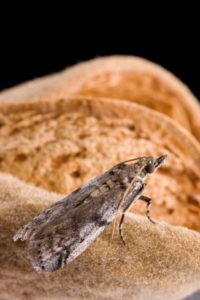New tools for controlling navel orangeworm – a leading pest in nut crops – don’t come down the pike very often. So, when Ryan Finnen, farm manager at Myers Seed and Trebec Farms, heard about the launch of KeyPlex’s AWP, he was eager to try it. AWP is an essential-oil based insecticide with multiple modes of action against lepidopteran pests, which includes navel orangeworm (NOW), as well as against mites and other insects.
Finnen manages 3,000 acres of almonds in Colusa County, CA. He says he saw very heavy NOW pressure last year and is seeing early activity this spring, although it is too early yet to judge. He was pleased enough with the results of trialing AWP last season that he is applying it to all his almonds this year.

Application of KeyPlex AWP in May to knockdown overwintered populations, and every 21 days from hull split through harvest, provides excellent protection against the navel orangeworm. Photo: Peggy Greb, USDA Agricultural Research Service
“Normally we do an early spray in May to knock down the population, and then starting at hull split, we spray every 10 to 14 days to make sure we have continual coverage when the nuts are susceptible,” Finnen says. “What we found with AWP is we could spray every 21 days and still see as good or better coverage. That’s a huge deal, because you have the confidence your crop is protected, but you’re doing it with less hassle, less labor and less material.”
The essential oils in AWP have acute toxicity, and research has shown they also act as a repellent. Finnen has seen that effect in his fields and thinks it is a reason why spray intervals can be extended to 21 days.
A zero reentry interval after application is another key advantage of AWP, one that Finnen says is significant given the need to protect the crop from NOW all the way through the end of harvest. Essential oils are GRAS, or Generally Recognized As Safe by EPA, so workers can reenter the field immediately after application. And because there are no maximum residue restrictions, the harvest can continue without interruption.
“If you can keep the crop protected even during the harvest from NOW damage, and keep workers safe and in the field, that’s a big savings,” Finnen says.
Better for Beneficials
Having essential oils as the active ingredient also means AWP is a softer chemistry and takes less of a toll on beneficial insects. Studies have shown that beneficials return much sooner to fields sprayed with essential oils than they do after stronger chemistries.
“We typically use strong, broad-spectrum products that are effective on the navel orangeworm, but they also take out the beneficials,” Finnen says. “University research shows that beneficials are really your best protectors against mites. If you kill your beneficials, you’re going to have to come back with a miticide, and some of the latest technologies can be $60/acre to spray. We’re really hoping this year that using AWP will allow us to keep our beneficial population.”
Multiple Modes of Action Prevent Resistance
Another plus for essential oils is they are not single molecule products. Botanical oils contain complex molecules with multiple modes of action, making it nearly impossible for pests to develop resistance. AWP was customized for difficult insects such as NOW.
“We selected different molecules with different modes of action and put them together to maximize performance,” says Gerald O’Connor, CEO of KeyPlex. “AWP provides repellency as well as knock down and mortality on contact. And while it’s not a mating disruptor, it does deter egg laying.”
“We’re excited about AWP long term, because of the almost-zero risk of resistance buildup,” Finnen says. “Many growers are getting nervous because we had a product that worked really well a few years ago, but we’re starting to see resistance now. And there’s just not much coming down the pike.”
Essential oils can be used in rotation with traditional chemistries, extending those products’ efficacy. The oils can be tank-mixed with conventional insecticides, as well, and can even make them more effective. “Essential oils are very good penetrants and can help make traditional chemistries more effective by getting them through the exoskeleton of the insect or into the disease organism where they can have a stronger effect,” O’Connor says.
Finnen says he saw that effect last year when he tank-mixed AWP and Intrepid, an effective growth regulator insecticide.
“The results of Intrepid alone versus those from Intrepid plus AWP were dramatic. The combination with AWP just really performed very, very well,” Finnen says.
